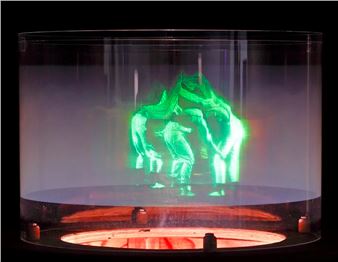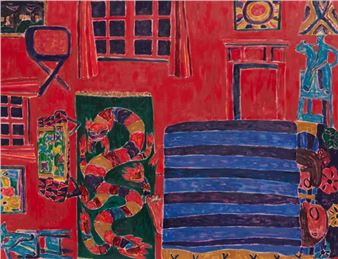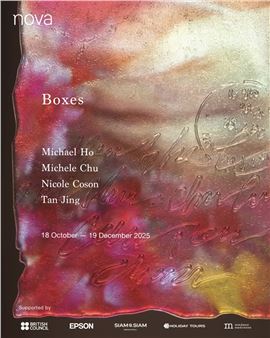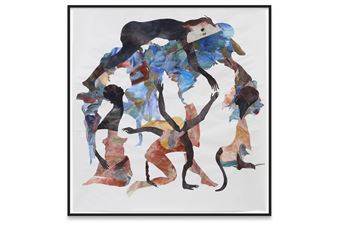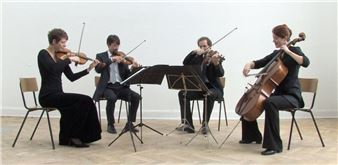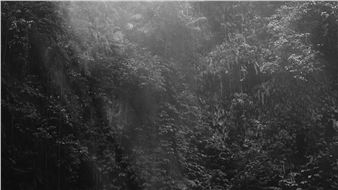Maria Taniguchi
carlier | gebauer, Berlin, is delighted to announce Maria TaniguchiŌĆÖs third solo exhibition with the gallery, where she presents her most recent paintings. Initially trained as a sculptor, Taniguchi has created a body of work spanning video as well as sculpture, however her oeuvre is mainly composed by canvases: her signature monochrome ŌĆ£untitledŌĆØ brick paintings. They occupy the threshold between painting and sculpture, since the artist exhibits her monumentally sized canvases leaning onto the walls of the exhibition space.
TaniguchiŌĆÖs latest works initially seem to mark a chromatic shift, moving away from the opaqueness of the greyish surface to revealing reddish hues. While these recent paintings appear translucent in contrast to previous ones, they bring to attention how this aspect of transparency was always a part of TaniguchiŌĆÖs practice. Further, they highlight the subtle alterations within a method the artist has been rigorously employing over the past seventeen years. Taniguchi first creates the base by priming the canvas, then adds the drawing on top. Its graphite lines create the pattern of bricks. Finally, one by one each brick is painted. In this last step, Taniguchi experiments with different pigments, by this way small amounts of colours made their way into the brick grid. These shifts and alterations become apparent upon close observation of individual paintings, especially in constellations of larger groupings.
With her newest pieces, Taniguchi turns her attention to the initial step, by leaving the canvas ungrounded. Through this alteration at the beginning of the process, a quality is accentuated that the works attain with the last step: their transparency, inherent to them since Taniguchi first began this body of work in 2008. The scale of these early canvases was determined by the constraints of her space, the largest being confined by the dimensions of the room used by Taniguchi for painting. Since then, every work has become part of a meticulous structure, expanding a framework exposing its own contingency. Even though the specific conditions Taniguchi sets for each work remain in their core unchanged, within this structure the final result is left to fortuitousness. Almost paradoxically said, Taniguchi creates a method to paint chance into a pattern. This methodology of repetition resembles in its precision the one of a natural scientist, setting up for an experiment, while her disciplined commitment, one could term it as obsessiveness, denotes a meditative, nearly spiritual aspect of her practice. Nonetheless, it is not at all detached from the bodily realm, rather firmly rooted in it, functioning as a manifestation of labour and time poured by Taniguchi into the genesis of the work.
As a durational act of repetition, her particular approach carries beyond what a body can endure, even further beyond the entity of a single canvas. In regard to TaniguchiŌĆÖs practice, repetition and structure inform it both as formal principles and the subjects of her work. Each work accumulates to the existing structure, created as a result of a labour and time intensive approach. This process allows transmutations to occur, where labour is transmuted into time. In this respect TaniguchiŌĆÖs canvases can be described as monuments to time, to the dedication of an artist to their lifework, inviting the viewer to closely observe the elusive patterns in their surface, reflecting her choice of materials as well as the labour consolidated within these works.

Recommended for you
carlier | gebauer, Berlin, is delighted to announce Maria TaniguchiŌĆÖs third solo exhibition with the gallery, where she presents her most recent paintings. Initially trained as a sculptor, Taniguchi has created a body of work spanning video as well as sculpture, however her oeuvre is mainly composed by canvases: her signature monochrome ŌĆ£untitledŌĆØ brick paintings. They occupy the threshold between painting and sculpture, since the artist exhibits her monumentally sized canvases leaning onto the walls of the exhibition space.
TaniguchiŌĆÖs latest works initially seem to mark a chromatic shift, moving away from the opaqueness of the greyish surface to revealing reddish hues. While these recent paintings appear translucent in contrast to previous ones, they bring to attention how this aspect of transparency was always a part of TaniguchiŌĆÖs practice. Further, they highlight the subtle alterations within a method the artist has been rigorously employing over the past seventeen years. Taniguchi first creates the base by priming the canvas, then adds the drawing on top. Its graphite lines create the pattern of bricks. Finally, one by one each brick is painted. In this last step, Taniguchi experiments with different pigments, by this way small amounts of colours made their way into the brick grid. These shifts and alterations become apparent upon close observation of individual paintings, especially in constellations of larger groupings.
With her newest pieces, Taniguchi turns her attention to the initial step, by leaving the canvas ungrounded. Through this alteration at the beginning of the process, a quality is accentuated that the works attain with the last step: their transparency, inherent to them since Taniguchi first began this body of work in 2008. The scale of these early canvases was determined by the constraints of her space, the largest being confined by the dimensions of the room used by Taniguchi for painting. Since then, every work has become part of a meticulous structure, expanding a framework exposing its own contingency. Even though the specific conditions Taniguchi sets for each work remain in their core unchanged, within this structure the final result is left to fortuitousness. Almost paradoxically said, Taniguchi creates a method to paint chance into a pattern. This methodology of repetition resembles in its precision the one of a natural scientist, setting up for an experiment, while her disciplined commitment, one could term it as obsessiveness, denotes a meditative, nearly spiritual aspect of her practice. Nonetheless, it is not at all detached from the bodily realm, rather firmly rooted in it, functioning as a manifestation of labour and time poured by Taniguchi into the genesis of the work.
As a durational act of repetition, her particular approach carries beyond what a body can endure, even further beyond the entity of a single canvas. In regard to TaniguchiŌĆÖs practice, repetition and structure inform it both as formal principles and the subjects of her work. Each work accumulates to the existing structure, created as a result of a labour and time intensive approach. This process allows transmutations to occur, where labour is transmuted into time. In this respect TaniguchiŌĆÖs canvases can be described as monuments to time, to the dedication of an artist to their lifework, inviting the viewer to closely observe the elusive patterns in their surface, reflecting her choice of materials as well as the labour consolidated within these works.

 ARTISTS
ARTISTS







